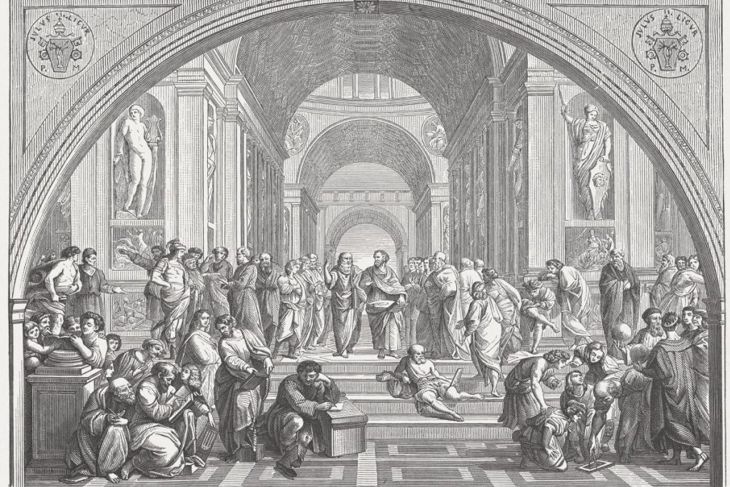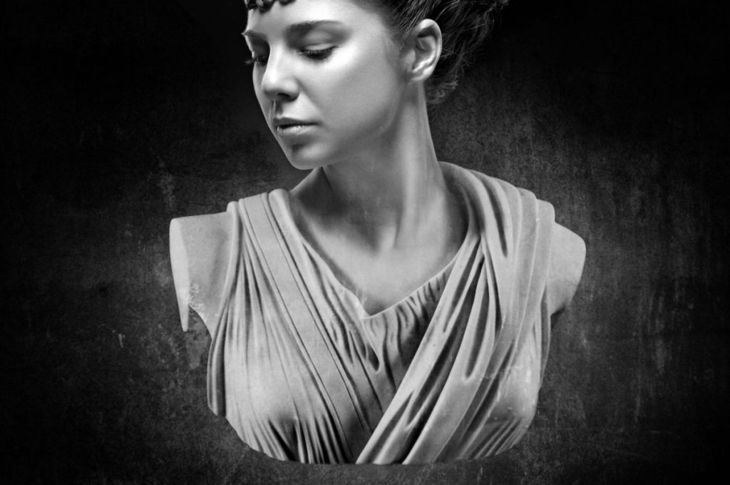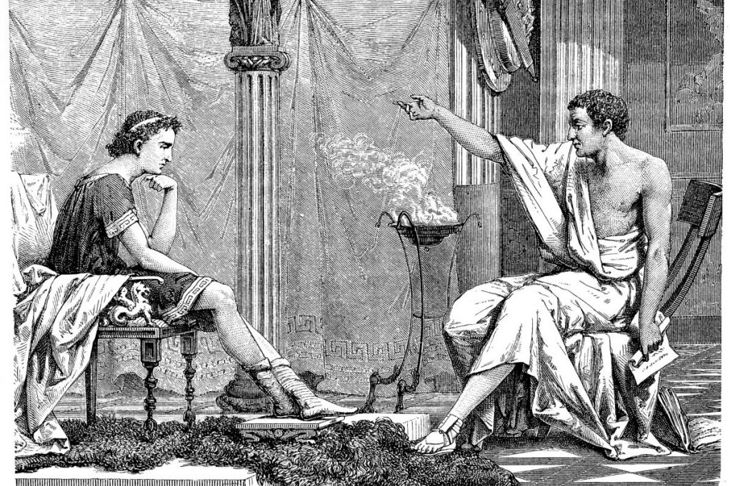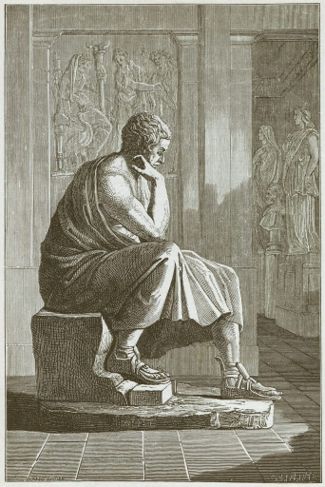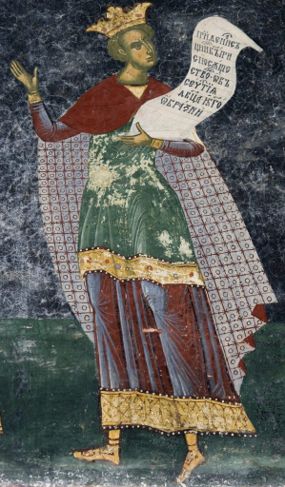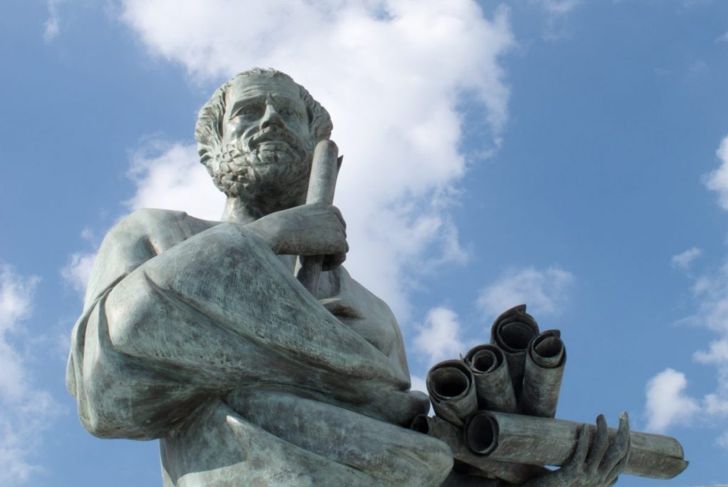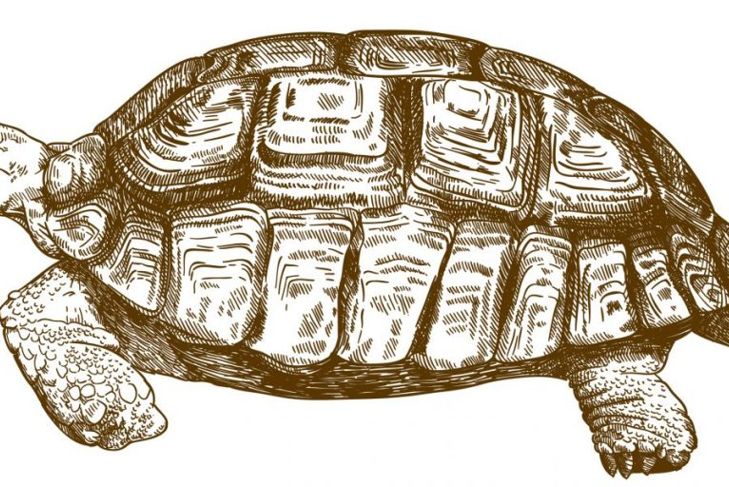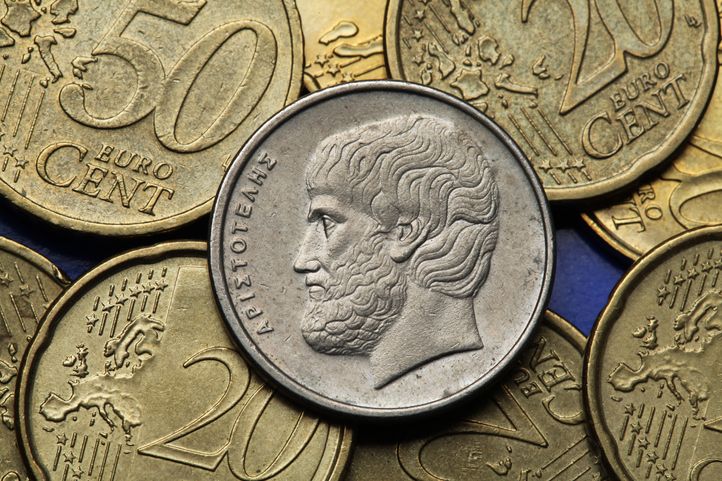Considered the “Father of Western Philosophy,” Aristotle was born in 384 BCE in Stagira, a small town in northern Greece on the Chalcidice peninsula. Little is known of his life, but his mother, Phaestis, had two other children, sister Arimneste and brother Arimnestus, with his father, Nicomachus, a court physician to Amyntas III, king of Macedonia. Orphaned as a boy, Proxenus of Atarneus, his sister’s husband, became his guardian. Aristotle was educated for a couple of years until he was sent to the Academy at seventeen where Plato was his teacher.
Disagreement with Plato
For the next 20 years, Aristotle and Plato were close friends until Plato’s death but had a philosophical disagreement that would cause Aristotle to not be offered the Academy directorship after his mentor’s death. Their disagreement had to do with Plato’s belief that reasoning and thoughts were enough to prove a concept, whereas Aristotle had more empirical beliefs that relied on experience and observation with the senses.
Pythias of Assos
Hermias had studied under Plato at the Academy, and it was there that he met Aristotle. As king of Atarneus, he extended an invitation to Aristotle, who traveled to the Assos region under the King’s patronage. Once there, he met and married Pythias, a biologist, embryologist, and Hermias’ niece. Together they had a daughter, who came to be known as Pythias the Younger. Hermias was loyal to Philip II of Macedon and had revolted against Persian rule. History states that in trying to negotiate an alliance with Persia, Pythias was captured and executed in 341 BCE. According to historians, Aristotle’s Ode to Virtue was dedicated to her.
New Beginnings: the Lyceum
During Aristotle’s return to Macedonia in 338 BCE, he became the official tutor to King Philip II’s 13-year-old son Alexander III, who would become Alexander the Great. This lasted for about two years, and in 335 BCE, Aristotle returned to Athens after Alexander had conquered the city. With Alexander’s permission, he founded his own philosophical school, the Lyceum, located in a former wrestling school. While there were private students, he opened up the school to the public for free. Aristotle’s students were known as Peripatetics, as he had a habit of walking about the grove while lecturing. Students’ written arguments were collected by the school to create one of the first great libraries in history.
Impiety Charges and Exile
Aristotle spent most of his life teaching and lecturing and, eventually, started a romance with Herpyllis, a woman also from Stagira, who was said to be a slave. With her, he had more children, including a son, Nicomachus, named after his father. During this time, Alexander the Great became more power-hungry and Aristotle’s nephew and historian to Alexander, Callisthenes, was falsely executed. In 323 BCE, Alexander died, and the pro-Macedonian government was overthrown. Aristotle was formally charged with impiety, which was a capital offense, and fled the charges. He remained in exile on the island of Euboea until his death in 322 BCE. His will was preserved, and in it, he provided for his family as well as his slaves.
Survival of His Works
Because he was persona non grata, Aristotle’s works were hidden after his death by his protégé and successor, Theophrastus. After Theophrastus’ death, Aristotle’s works weren’t seen again until the first century BCE. Throughout the fall of Rome, he was read by thinkers, such as Avicenna, a Persian polymath, and Maimonides, a Sephardic Jewish philosopher and scholar. In the thirteenth century, theologian Thomas Aquinas merged Aristotelian and Christian thoughts to form the foundation for medieval Catholic philosophy.
Classification of His Works
Aristotle was said to have written over 200 treatises, but only about 31 survived. They were edited by Andronicus in Rome when they were rediscovered in the first century. Despite that, the logic that underpins his pieces is sound and they’re still highly influential. His works fall into four categories: organon, theoretical, practical, and rhetoric/poetics. Organon describes logic that’s used in philosophical or scientific understanding. Theoretical works are treatises about animals, metaphysics, cosmology, and physics. Practical is about familial, societal, and individual excellence, and rhetoric/poetic defines how language can move and inspire.
Classification of Sciences
Aristotle categorized sciences into productive, practical, and theoretical. Productive sciences include engineering and architecture as well as strategy and rhetoric for victory in court and on the battlefield. Ethics and politics, which govern behavior, are known as practical sciences, and theoretical sciences, such as theology, physics, and mathematics, have no practical goals, but the information is sought for its own sake.
Classified More Than 500 Animals
Aristotle insisted that animals were classified by genus and species and in his treatises, over 500 of them were organized in detail. Research suggests that Alexander would send back specimens to Aristotle whenever he went on raids. Interestingly, his detailed notes about some of the animals’ features could only be corroborated by the invention of the microscope more than 1,800 years later.
The inspiration for Chaos Theory
Chaos Theory is a mathematical branch that states that in systems that seem random, there is an underlying pattern. This is a working theory when it comes to subjects such as weather and climate. Aristotle observed that a slight deviation from the truth is significantly multiplied further down the line. Scientists have speculated that this may have been a first glance of the butterfly effect.
Other Famous Students of Aristotle
Alongside Alexander the Great, Aristotle had another notable pupil. Cassander was king of Macedonia from 305 BC to 297 BC. He was a contemporary of Alexander the Great and studied with him at the Lyceum. When Alexander died, he was succeeded by his son, Alexander IV. However, Cassander ascended to the Macedonian throne married Philip II’s daughter, Thessalonica, and then murdered Alexander IV.

 Home
Home Health
Health Diet & Nutrition
Diet & Nutrition Living Well
Living Well More
More